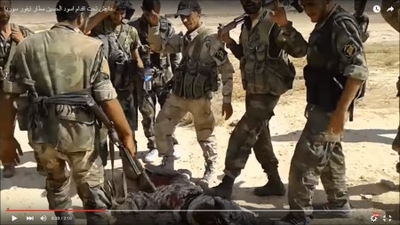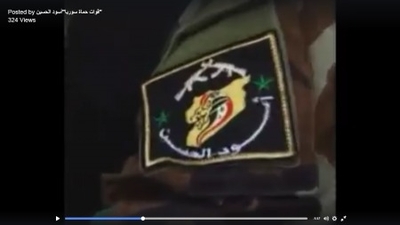
Original emblem of Liwa Usud al-Hussein.
The province of Latakia has seen a variety of militias operate in its territory in the bid to drive out rebel forces entirely from the coastal front, including the Muqawama Suriya, the Syrian Social Nationalist Party's Nusur al-Zawba'a, and Suqur al-Sahara'. Foreign Shi'a militias have also participated in Latakia battles, the most notable recent case being the Iraqi group Liwa Assad Allah al-Ghalib, which, according to one of its members I have spoken with, has some Syrian members and has personnel playing an advisory role in Suqur al-Sahara'. The links between Liwa Assad Allah al-Ghalib and Suqur al-Sahara' are borne out in recent social media output by the former, as per below as an example:

From the Latakia front: note the Liwa Assad Allah al-Ghalib flags and the Suqur al-Sahara' arm-patches.
Unlike the formations mentioned above, Liwa Usud al-Hussein (The Lions of Hussein Brigade) is a much newer militia based in Latakia, having been formed approximately 7 months ago (i.e. around late June-early July 2015), according to a media representative for the group. The formation of Liwa Usud al-Hussein thus came soon after the creation of Coastal Shield, a local militia affiliated with the Syrian army's Republican Guard that reflected a regime strategy at the time of both dealing with manpower shortages exacerbated by conscription avoidance and focusing on defending areas deemed strategically vital.
However, unlike Coastal Shield, Liwa Usud al-Hussein does not appear to claim affiliation with the Syrian army. The leader of the brigade- originally from Qardaha– is one Hussein Tawfiq al-Assad, undoubtedly part of the larger al-Assad family that is in Qardaha. One can understand the name of Hussein in the brigade's name in two ways: not only can it refer to the leader of the group, but also to Imam Hussein. Indeed, in an early video posted by Liwa Usud al-Hussein showing the group's presence in the Homs desert area near Palmyra, the accompanying soundtrack is the song "Salam Allah 'Ala Sawtak Habibi Ya Hussein" (God's peace be upon your voice, my beloved Hussein"). These data point to the Alawite background of the militia (for more on the status of Imam Hussein in Alawite theology, see this book by Yaron Friedman). This observation should not come as a surprise. Another militia in Latakia province, the Katibat al-Jabal, affiliated with the National Defence Forces and primarily based on the Nabi Yunis summit, has also made its Alawite affinities clear.
The main operations publicly claimed to date have been participation in the fighting in the Homs desert area near Palmyra against the Islamic State in July 2015, combat in the Sahl al-Ghab in the late summer of 2015, the offensive to take Marj al-Sultan airbase in the Damascus area towards the end of 2015, and most recently the new offensives in north Latakia province that have gone decisively against the rebels, who have suffered high attrition rates partly on account of the intense Russian airstrikes. Specifically in the most recent Latakia initiatives, Liwa Usud al-Hussein took part in the capture of Rabi'a, rather than the rebel stronghold of Salma. Over the course of all these campaigns, Liwa Usud al-Hussein has publicly claimed 3 'martyrs', two of whom were claimed to have been killed in the operations near Palmyra, and one in the Sahl al-Ghab battles.
However, it should be noted that discrepancies exist in the data for the two supposedly killed fighting for Liwa Usud al-Hussein near Palmyra: Nader Saleh Douba,originally from the village of al-Boudi to the southeast of Qardaha, and Rami Aboud Muhammad, originally from Bashnana in Tartous province. Rami is agreed by multiple sources to have been killed in the Aqrab area in Hama governorate, while Nader is variously said to have been killed either in north Homs or Jobar in Damascus. In fact, the media representative for Liwa Usud al-Hussein affirmed to me that only two 'martyrs' for the group are confirmed since the founding of the brigade, though names were not specified.

Militia commander Hussein al-Assad claimed to be posing in Rabi'a (Latakia) following its capture from rebel forces.

Screenshot from a video advertising the group's participation in operations near Palmyra, set to the soundtrack of "Salam Allah 'Ala Sawtak Habibi Ya Hussein."

Screenshot from a video showing Liwa Usud al-Hussein fighters posing over the corpse of a dead Islamic State fighter apparently in the T4 airbase area in the Homs desert. Note the distinct Liwa Usud al-Hussein arm-patches on two of the fighters (centre and right). For the soundtrack, see this video.

From a video posted by Liwa Usud al-Hussein, advertising a convoy as heading off to fight in the Palmyra area. Close-up of a car with the group's logo.

From the same video as the previous photo: Liwa Usud al-Hussein arm-patch.
As of now, the Liwa Usud al-Hussein media representative asserted to me that the brigade has undergone a reformation and reconstitution, now using the name "Quwat Humat Souriya- Usud al-Hussein" (Guardians of Syria Forces- Lions of Hussein). The precise reasons for this development were not made clear.

The new emblem of Liwa Usud al-Hussein under the name of Quwat Humat Souriya- Usud al-Hussein. On bottom, a familiar slogan: "Watan, Sharf, Ikhlas" (Homeland, Honour, Sincerity).
Like many other pro-Assad militias such as Liwa Khaybar, the number of 'martyrs' claimed by Liwa Usud al-Hussein suggests a very minor role in the overall conflict, but the group provides another interesting case study of militias on the regime side of the conflict.
-------------------------------------------------
Update (3 July 2018): Since very little social media data exist on Liwa Usud al-Hussein and in light of errors on Wikipedia's entry regarding this group, it is worth clarifying the present status of Liwa Usud al-Hussein and some details of its history, as related to me by a field commander from the group.
First, Liwa Usud al-Hussein is still active, but it is not affiliated with the Republican Guard or the IV Corps. Liwa Usud al-Hussein actually comes under the Latakia sector of the Iranian-backed Local Defence Forces (LDF) and is currently on assignment in the Albukamal and al-Mayadeen areas near the border with Iraq (many LDF units have undertaken assignments in that area).
In the beginning of its existence as a fighting formation, Liwa Usud al-Hussein was affiliated with the al-Bustan Association.* In 2014, Liwa Usud al-Hussein began working with Iran's Islamic Revolutionary Guard Corps (IRGC) and then developed an official affiliation with the IRGC in 2016. This affiliation has remained to this day and is embodied in the group's affiliation with the LDF. As part of the campaign to recapture Deir az-Zor from the Islamic State, Liwa Usud al-Hussein engaged in joint operation assignments with the Tiger Forces.
The name change to "Quwat Humat Souriya- Usud al-Hussein" occurred as a result of Liwa Usud al-Hussein's incorporation of 200 fighters who had relations with the Russians. A name change was thus requested. However, at the present time, Liwa Usud al-Hussein has no relations with the Russians in terms of fighters and operation.
*- Note that the main article above dates Liwa Usud al-Hussein's formation to June/July 2015, but this should be understood in reference to being constituted with the familiar name, imagery and the emergence of the brand in the public domain through a (limited) social media profile. Like Saraya al-Areen and other groups, Liwa Usud al-Hussein's existence as an armed contingent predates the time it began to make itself known in the open source realm.

